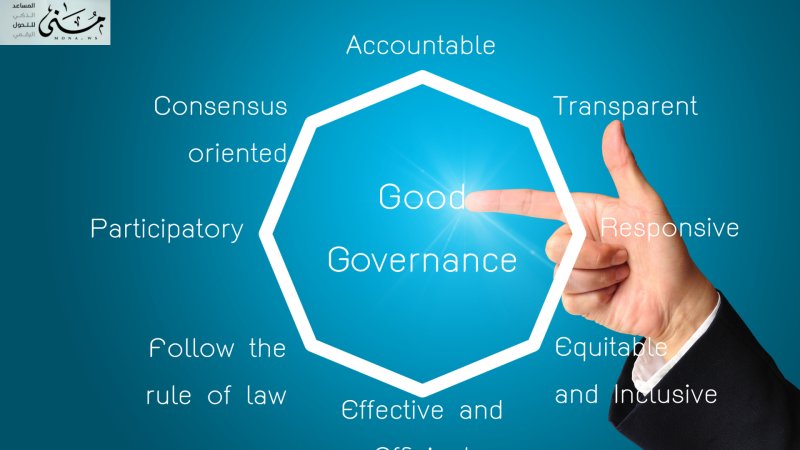Corporate governance has become an essential element in the success of any organization, whether in the public or private sector, as it contributes to enhancing transparency, improving administrative performance, and reducing risks.
In this article, we will review the concept of governance, its role in supporting innovation and investment, and the most important systems that can be relied upon to enhance its efficiency within institutions.
Corporate Governance Concept
Corporate governance means establishing frameworks and systems that ensure effective management, transparency and accountability within the organization, which is an essential element in the success of any organization, whether governmental or private.
Good corporate governance is based on clear standards that regulate the relationship between stakeholders such as investors, executive management, employees, and customers, which enhances market confidence in the organization.
Corporate governance is not only about compliance with laws, but also about improving corporate performance, reducing risks, and increasing operational efficiency, which leads to enhanced growth and sustainability.
Governance helps organizations avoid administrative corruption and abuse of power, as it obliges departments to follow clear policies based on transparency and accountability. It also enhances innovation by providing a stable work environment based on modern systems for managing operations.
This is where digital technologies like the system come in.DocSuite, an integrated system that contributes to enhancing governance by intelligently managing documents and organizing administrative communications according to modern standards.
Basic Principles of Corporate Governance
Corporate governance is based on a set of principles that form the basis for its success and sustainability. The most important of these principles are:
Transparency and DisclosureIt is essential that all financial and management information is clear and available to stakeholders, which contributes to making decisions based on accurate data.
AccountabilityEach party within the organization must be accountable for its actions before the competent authorities and stakeholders.
Justice and equalityEquality must be achieved among all stakeholders within the organization, whether they are employees, investors, or shareholders.
Effective risk managementSuccessful organizations rely on sophisticated risk management systems to avoid crises and make decisions based on careful analysis.
To effectively implement these principles, organizations can rely on specialized systems such as DocSuite andSAP GRC helps manage governance, risk, and compliance, ensuring that corporate policies are implemented effectively.

Tools and systems to support corporate governance
In the digital age, relying on technical solutions has become a necessity to achieve effective governance. There are many systems that allow organizations to apply governance standards in innovative ways, such as:
systemDocSuiteThis system provides integrated management of documents and communications, facilitating documentation and transparency processes within institutions.
systemOracle Governance, Risk, and Compliance:Helps monitor compliance and analyze risks in advanced ways.
systemCOBIT:An IT governance framework that helps manage digital operations according to clear standards.
The use of these systems not only ensures compliance with corporate governance standards, but also enhances work efficiency, reducing human errors, speeding up administrative processes, and providing an environment based on intelligent analysis and data-driven decision-making.
Challenges Facing the Implementation of Corporate Governance
Despite the many benefits of corporate governance, many companies face challenges in implementing it, including:
internal resistance to changeTraditional employees and departments may find it difficult to adopt new governance systems, this can be overcome through training programs and workshops that explain the benefits of governance.
High cost of some systemsSome organizations suffer from the high cost of advanced digital systems, this can be addressed by gradually investing in the most necessary technical solutions.
Lack of corporate culture around governanceOrganizations need to foster a culture of transparency and accountability through clear policies and internal regulations.
As the need for effective corporate governance grows, it has become imperative to integrate intelligent systems into day-to-day management operations. Modern technologies such as artificial intelligence and predictive analytics play a key role in enhancing transparency and accountability, helping organizations make more accurate strategic decisions.
How is technology reshaping corporate governance?
Digital governance has become an indispensable necessity for organizations seeking to achieve transparency and effectiveness in decision-making. Instead of traditional methods that rely on paper documents and manual procedures, organizations are adopting advanced digital systems to manage operations and internal control.
For example, technical solutions such as:DocSuite improves corporate management by automating processes, reducing human errors and accelerating decision implementation. The system also provides intelligent interfaces for managing official documents and administrative decisions in a way that ensures compliance with modern governance standards.
The relationship between governance and innovation
Governance is often thought to stifle innovation because of the strict rules and policies it imposes, but the truth is that good governance creates a safe environment that helps employees innovate within a structured framework. Successful organizations are those that balance regulatory controls with allowing space for innovation, making them more adaptable to changes in the market.
Modern systems such as:COBIT helps achieve this balance, providing a framework for IT governance, allowing organizations to adopt new solutions without compromising institutional controls.
Also, tools likeSAP GRC helps enforce governance policies while allowing levels of flexibility that enable continuous improvements in products and services.
Corporate Governance and Social Responsibility
Corporate governance is no longer limited to compliance with internal laws, but has become an essential part of corporate social responsibility ((CSR) Companies that adhere to effective governance practices have a positive impact on society and the environment, as they establish clear sustainability policies, such as reducing the carbon footprint, ensuring employee rights, and contributing to community development.
For example, digital document management systems such asDocSuite helps reduce paper consumption within organizations, which contributes to achieving environmental sustainability goals. In addition, enhancing transparency and accountability within the organization enhances the confidence of the public and shareholders in it, which supports its reputation in the market.
Measuring the effectiveness of corporate governance
In order for organizations to measure their success in implementing governance, key performance indicators must be identified (KPIs) that reflect the extent to which strategic objectives are achieved. Among the most important of these indicators are:
- Level of compliance with laws and regulations
- The extent of achieving transparency in financial and administrative reports
- Speed and efficiency of administrative decision making
- Degree of employee and shareholder satisfaction with management practices
Specialized systems such as:SAP GRC analyzes these indicators in detail, enabling departments to make immediate improvements when needed. Tools like Oracle GRC also enable risk prediction and proactive decisions to avoid potential issues.
Comparison between the governance of government institutions and private companies
Although the principles of corporate governance apply to all types of organizations, there are fundamental differences between the application of corporate governance in government institutions and private companies. Learn about them through the table:
|
The element |
Government institutions |
Private companies |
|
Main objective |
Achieving compliance with laws, transparency, community service and the public interest. |
Achieve operational efficiency, increase profits, and maximize shareholder value. |
|
Legal Framework |
It is subject to strict government regulations and legislation that determine its operations and policies. |
It follows commercial and regulatory laws but has greater flexibility in management. |
|
Oversight and accountability |
Subject to government audit and accountability from regulatory bodies and parliament. |
It relies on the oversight of shareholders, boards of directors, and financial reports. |
|
Decision making |
Decisions are made bureaucratically according to fixed regulations. |
You have greater flexibility in making decisions based on market strategies. |
|
Transparency and Disclosure |
Obligated to disclose financial statements and management decisions publicly. |
You are committed to making disclosures in accordance with market and shareholder requirements, but not necessarily publicly. |
|
Finance and Budget |
Depends on government budget and taxes. |
It depends on investments, loans, and sales revenues. |
|
Innovation and development |
Often restricted by laws and bureaucracy. |
Have greater flexibility to innovate and expand based on market requirements. |
|
Governance Systems |
Systems such as:DocSuite to automate processes and achieve government compliance. |
It depends on systems such as:SAP GRC and COBIT to enhance compliance and improve performance. |
The governance of government institutions and private companies differs in objectives, management methods, and flexibility in decision-making. While government institutions focus on strict compliance and public accountability, private companies seek to balance compliance and flexibility to increase profitability and growth. With the digital development, reliance on modern governance systems has become necessary to ensure efficiency and transparency in both sectors.
In the modern business world, corporate governance is no longer just an organizational obligation, but has become a fundamental pillar for achieving success and sustainability, and with the adoption of advanced digital solutions such asDocSuite and SAP GRC, it is now possible to enhance compliance, improve performance, and attract investors with greater confidence. The future is moving towards digital governance, and organizations that recognize and adapt to this shift will be best able to achieve leadership and excellence in an ever-changing competitive market.
 حوكمة المؤسسات ركيزة أساسية لتحقيق النجاح والاستدامة
حوكمة المؤسسات ركيزة أساسية لتحقيق النجاح والاستدامة











Comments
Add New Comment